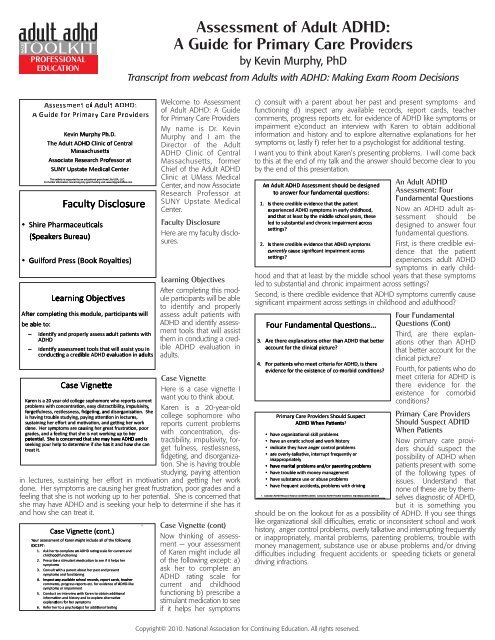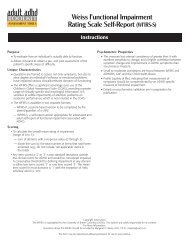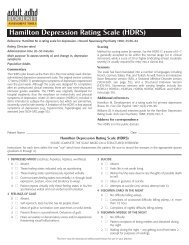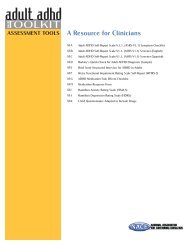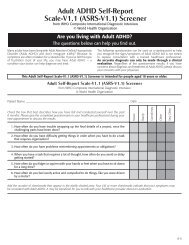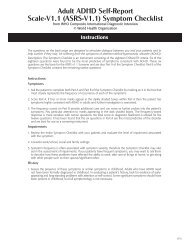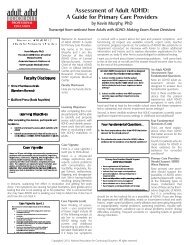Assessment of Adult ADHD: A Guide for Primary Care Providers
Assessment of Adult ADHD: A Guide for Primary Care Providers
Assessment of Adult ADHD: A Guide for Primary Care Providers
You also want an ePaper? Increase the reach of your titles
YUMPU automatically turns print PDFs into web optimized ePapers that Google loves.
emotional self control and emotional over reactivity; impulsive decisionmaking; and, general disorganization whether in their personal lives or inthe workplace. <strong>Adult</strong>s with <strong>ADHD</strong> <strong>of</strong>ten appear to be quite discom -bobulated throughout their life.Impact <strong>of</strong> ExecutiveFunction Deficits on<strong>Adult</strong> Functioning (2)<strong>Adult</strong>s with <strong>ADHD</strong> havedifficulty keeping promisesand commit ments toothers, or they may beviewed as being unreliableor inconsistent. They mayhave trouble followingthrough, difficulty multitasking or keeping track <strong>of</strong>several things at once, and seeing things through to completion.An inability to stop an enjoyable activity and shift to a more important taskis <strong>of</strong>ten impaired. People with <strong>ADHD</strong> have great difficulty doing what theyare supposed to do when they are supposed to do it consistently. They<strong>of</strong>ten need somebody to depend on <strong>for</strong> maintaining order and goaldirection as it is very hard <strong>for</strong> them to do complex tasks by themselves.Often times they need somebody to help them stay on track and keepthem going in the right direction.Impact <strong>of</strong> ExecutiveFunction Deficits on<strong>Adult</strong> Functioning (3)There is a sense <strong>of</strong> under -achievement where peopledo poorly in school despiteaverage or above averageor even superior intelli -gence. This under achievement<strong>of</strong>ten affectsjobsuccess, impairs work per -<strong>for</strong>mance, and may resultin unsatisfactory relationships in marriages or co-worker relationships orpeer relationships. As I mentioned poor driving outcomes are verycommon in adult <strong>ADHD</strong>, poor money management, saving <strong>for</strong> retirementand impulsive spending pose real problems.Trouble doing routine tasks <strong>of</strong>daily life, organizing a household, raising children, parenting, and payingbills show how pervasively this condition affects people in their day to dayfunctioning. So in the assessment you are go to look <strong>for</strong> clues to helpyou illicit some <strong>of</strong> these areas <strong>of</strong> difficulty that are so common to adultswith <strong>ADHD</strong>.<strong>ADHD</strong> <strong>Assessment</strong>PrinciplesNow <strong>for</strong> a couple <strong>of</strong> essen -tial as sess ment prin ci ples,it is very important to be asthorough and comprehen -sive as possible. We don’tassess this condition in asurface level or just givesomebody a rating scale,count symp toms, and con -clude that they must have <strong>ADHD</strong>. So we are not just doing a surface leveljob here, we need to be more comprehensive. I am going to tell you howto do that in an expedient way in a just a few minutes.Whenever possible you want to include collateral in<strong>for</strong>mants whengathering assessment data. Typically, this is either a spouse, or a parent, ora sibling, or somebody who has known the person well <strong>for</strong> a long time. Itis very important to get multiple sources <strong>of</strong> in<strong>for</strong>mation when possible.Obtaining historical records when available is very, very helpful. This helpsto establish the chronicity, the onset and the pervasiveness <strong>of</strong> impairmentthat is mentioned in the next bullet here.School records, report cards, job per<strong>for</strong>mance reviews, medical recordsthings like that can really help us to take a look at the paper trail,it’s a testament to the person’s developmental deviance over time.We also need to rule out other conditions that might better explain<strong>ADHD</strong> symptoms.More about ruling out, what do we tend to rule out? Well we have toconsider if there are better explanations <strong>for</strong> existing problems be<strong>for</strong>e weconclude that someone has <strong>ADHD</strong>.Ruling Out AlternativeExplanations <strong>for</strong> <strong>ADHD</strong>SymptomsWe need to rule out tran -sient situational stressorsas an explanation <strong>for</strong><strong>ADHD</strong>-like symptoms.A divorce, a career change,a job change, grief reaction,family or lifestyle changes,people having babies ortwins, or getting married, or things like this can produce stress and <strong>ADHD</strong>likesymptoms.Also we have to rule out medical conditions that may also mimic <strong>ADHD</strong>Symptoms these include things like: chronic fatigue, thyroid difficulties,diabetes, even menopause, and medication side effects. We also need torule out other psychiatric disorders as being responsible <strong>for</strong> the symptoms,not only ruling out but also looking at whether they coexist with the <strong>ADHD</strong>.Typically these are things like bipolar disorder, substance abuse, depression,anxiety disorders or personality disorders.<strong>Assessment</strong> Tools toHelp Diagnose <strong>Adult</strong><strong>ADHD</strong>Here are some assess menttools to help diag nose<strong>ADHD</strong>. These are the toolsthat are going to help youanswer those four funda -mental questions that Imentioned in the begin -ning — these are at the heart<strong>of</strong> an <strong>ADHD</strong> evaluation.So those are the questions you want to ask and these are the tools thatyou are going to use to answer those questions.There are four major things we use to conduct as assessment: structuredinterview tools, symptom rating scales, historical records and neuro -psychological tests. We are not going to concern ourselves so much withneuropsychological tests in this talk because suffice it to say thatneuropsych tests are not diagnostic <strong>of</strong> <strong>ADHD</strong>. They do help us to betterunderstand strengths and weaknesses and may help in establishcomorbidity but we’ll focus on the other three areas at this time.Components <strong>of</strong> an<strong>ADHD</strong> EvaluationIt’s Important <strong>for</strong> you tounderstand that a typicalevaluation does not requirelengthy, structured inter -views or a comprehensiveneuropsychologicaltestbattery. <strong>ADHD</strong> assessmentdoes not have to be anonerous difficult process.We can do this fairly reliably in a relatively quick way. Accurate diagnosiscan be obtained by doing a careful, traditional history taking and a recordsreview, combined with the use <strong>of</strong> symptom rating scales and a clinicalinterview that focuses on the <strong>ADHD</strong> diagnostic criteria.This is the nub <strong>of</strong> what I want to talk to you about in this segment.' ' ' '' ' 'a*
Situational Variability <strong>of</strong><strong>ADHD</strong> SymptomsAnother important point tounderstand is the situa -tional variability <strong>of</strong> <strong>ADHD</strong>symp toms. Many peopledon’t understand this incon -sis tency. <strong>Adult</strong>s may functionbetter in one settingversus another. The guide -lines here are, if the task isinherently interesting, if it ishigh stakes, if it is novel, if it is exciting, if it is highly relevant to what theylike, they may look quite normal. But when the task is boring, repetitive,low interest or irrelevant to them they have a great deal <strong>of</strong> difficulty andsymptoms become exacerbated. That is why you see a great deal <strong>of</strong>variability at school and work.It is important to get spousal reactions. Spouses <strong>of</strong>ten feel overburdenedat times. They feel they have to be the glue that keeps things together.They have to be on top <strong>of</strong> things because their <strong>ADHD</strong> spouse is unreliable.They feel very frustrated in the relationship.Summary—Key<strong>Assessment</strong> PointsIt is very important as aprimary care doc that youhave a conversation withyour patient. Some <strong>of</strong> thisstuff doesn’t come outuntil you invite a conversa -tion and hear their story alittle bit. It doesn’t have tobe an overly lengthy conver -sation. In the <strong>Adult</strong> <strong>ADHD</strong>Toolkit you will have some questions in a brief interview that are designedto help you get at this conversation started.Summary—Key<strong>Assessment</strong> Points (2)First, <strong>ADHD</strong> is a legitimateand serious disorder that isassociated with significantimpairment in multiple lifedomains including school,work, social relationships,driving, money manage -ment, and daily adaptivefunctioningSecondly, <strong>ADHD</strong> is associated with significant comorbidity — mostcommonly oppositional defiant disorder, conduct disorder, substanceabuse, dysthymia, major depression, and anxiety disordersAlso, <strong>ADHD</strong> has an onset in early childhood or adolescence, persists intoadulthood in most cases, and causes chronic and pervasive impairmentover time and across situations<strong>ADHD</strong> is not an adult-onset disorder. It does not suddenly arise in adult life.Clinicians should always attempt to rule out other reasons <strong>for</strong> <strong>ADHD</strong>-likesymptoms be<strong>for</strong>e concluding <strong>ADHD</strong> is present.Summary—Key<strong>Assessment</strong> Points (3)A trial <strong>of</strong> a stimulant medi -cation is not a test <strong>for</strong><strong>ADHD</strong>. And this is notsomething that should bedone as part <strong>of</strong> an assess -ment, rather medi cationshould be prescribed afterthe assessment when youhave a good idea thatthis person does meetcriteria <strong>for</strong> <strong>ADHD</strong> and a medication is appropriate. Don’t do a trial balloonin the beginning to see if there is a positive reaction. In fact, most peopletaking a stimulant, whether they have <strong>ADHD</strong> or not, would respond in apositive manner.Another thing to remember is that there is no litmus test <strong>for</strong> <strong>ADHD</strong>—noneuropychological test battery, no brain scan that can be used to determinewhether <strong>ADHD</strong> is present or not. The assessment tools described hereshould be used n combination and not used as a stand alone diagnosticmeasures.We need to use the rating scales, interviews with patients and collateralin<strong>for</strong>mants, testing, and historical records in combination to help us makethe best and most in<strong>for</strong>med judgments about diagnosis.The <strong>Adult</strong> <strong>ADHD</strong> Toolkit can help you very much make more sense out <strong>of</strong>all this and gives you a blueprint <strong>of</strong> how to do this effectively.Case VignetteNow getting back to the case vignette, I am not going to read it again, butafter listening to this presentation your answer here is all the choices arecorrect EXCEPT prescribing stimulant mediation as part <strong>of</strong> the assessment.I hope this helps you understand <strong>ADHD</strong> assess ment better in this segment.Thank You' ' ' '' ' 'D$53"I,%"4'U";$"P$4$5=',B'1-8-'D=*


